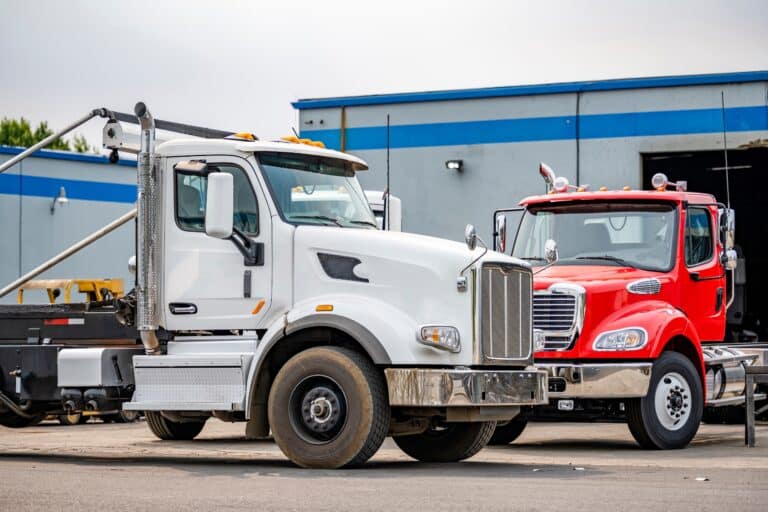In trucking, staying on top of commercial driver’s licences (CDL) regulations is crucial for both drivers and carriers. These regulations are necessary to the industry. They help improve safety on our highways and maintain professional standards for truckers. This article delves into the intricate world of CDL driving regulations, offering a comprehensive guide for both seasoned truckers and those new to the field.
From the basics of CDLs to the latest electronic logging devices, we’ll explore how these regulations shape the trucking landscape. Our goal is to provide truckers with a clear understanding of the rules that govern commercial driving, help them navigate compliance challenges, and introduce tools that can make regulatory adherence easier. Whether you’re a fleet manager looking to optimize operations or a driver aiming to stay compliant, this guide will equip you with the knowledge you need to succeed in today’s trucking industry.
Do you have any questions? Talk to ELD Advisor: 650-405-3372 or Request Callback
The Basics of CDL Driving Regulations
In Canada, commercial driver’s licences are categorized differently than in the United States:
- Class 1 Licence. This is the equivalent of the U.S. Class A CDL. It allows drivers to operate tractor-trailers and any motor vehicle or combination of vehicles, except motorcycles.
- Class 2 Licence. This permits the operation of buses with a seating capacity of more than 24 passengers.
- Class 3 Licence. This is for trucks with more than two axles, including tow trucks. It’s similar to the U.S. Class B CDL.
- Class 4 Licence. This covers taxis, ambulances, and small buses (up to 24 passengers).
Each class has its own set of requirements, including written and road tests that assess a driver’s knowledge and ability to operate the relevant vehicles safely.
The regulation of commercial driver licensing in Canada is primarily a provincial and territorial responsibility. Unlike the US, where there’s a federal agency overseeing CDL regulations, in Canada, each province and territory sets its own specific requirements and issues licences.
However, there is a degree of standardization across the country. The Canadian Council of Motor Transport Administrators (CCMTA) works to harmonize rules and regulations related to motor vehicle transportation and highway safety. They’ve developed the National Safety Code (NSC), which provides a set of national standards for the safe operation of commercial vehicles.
While provinces and territories are responsible for implementing these standards, the federal government plays a role in regulating interprovincial and international trucking through Transport Canada and other agencies.
This system allows for consistency in commercial driver standards across Canada while giving provinces and territories the flexibility to address their specific needs and conditions. It’s an approach that aims to maintain high safety standards across the country while respecting the jurisdictional responsibilities of each province and territory.

Hours of Service Regulations
One of the most crucial aspects of CDL driving regulations is the hours of service (HOS) rules. These regulations are designed to prevent driver fatigue, a major cause of truck-related accidents. By limiting the number of hours a driver can work, HOS rules aim to ensure that commercial drivers are alert and safe on the road.
So, how many hours a day can a CDL driver drive? The current HOS regulations include several key provisions:
- Daily driving limit. Drivers can drive for a maximum of 13 hours in a day.
- Daily on-duty limit. Drivers can be on duty for a maximum of 14 hours in a day.
- Daily off-duty time. Drivers must have at least 10 hours off-duty in a day, including at least 8 consecutive hours.
- Work shift rule. Drivers must stop driving after 16 hours have elapsed since the start of their work shift.
- Cycle limits. Drivers must follow either Cycle 1 (70 hours on-duty time in 7 days) or Cycle 2 (120 hours on-duty time in 14 days).
- Reset provision. Drivers can reset their cycle by taking 36 consecutive hours off-duty (for Cycle 1) or 72 consecutive hours off-duty (for Cycle 2).
- Mandatory breaks. Unlike U.S. regulations, Canadian rules don’t mandate specific break times, but off-duty time is built into the daily and work shift limits.
- Sleeper berth provision. Drivers using a sleeper berth can split their required off-duty time into two periods, with specific conditions.
Violating these regulations can have serious consequences. Penalties for HOS violations can include fines, being placed out-of-service (which means the driver can’t operate the vehicle for a specified period), and negative impacts on a carrier’s safety rating. For individual drivers, violations can lead to licence suspension or even disqualification, potentially ending their career in the industry.
It’s crucial for both drivers and carriers to take these regulations seriously. Not only do they help prevent accidents, but they also create a level playing field in the industry, ensuring that no one gains an unfair advantage by pushing drivers beyond safe limits.
Electronic Logging Devices (ELDs) and CDL Driving Regulations
In recent years, the landscape of HOS compliance has been transformed by the introduction of electronic logging devices (ELDs). These devices have become a cornerstone of modern CDL driving hours regulations, replacing the traditional paper logbooks that drivers used for decades.
ELDs are electronic hardware devices that connect to a vehicle’s engine. They automatically record driving time and monitor engine hours, vehicle movement, distance driven, and location information. This automation helps ensure accurate logging of a driver’s hours of service, making it easier to comply with HOS regulations.

The Canadian ELD mandate was implemented more recently than its American counterpart:
- June 12, 2021. The ELD mandate came into effect, but with a progressive enforcement period.
- January 1, 2023. Full enforcement of the ELD mandate began.
There are some exceptions to this mandate, including:
- Commercial vehicles operated by carriers with a permit exempting them from keeping a daily log
- Commercial vehicles under a short-term rental agreement (30 days or less)
- Commercial vehicles manufactured before the year 2000
It’s important to note that unlike in the US, Canadian regulations require ELDs to be certified by accredited third-party certification bodies.
Apart from compliance with federal legislations, electronic logbooks offer several benefits, including:
- Improved accuracy. ELDs eliminate the potential for human error in recording hours, ensuring more accurate logs.
- Time savings. Drivers spend less time on paperwork, as the devices automate much of the logging process.
- Easier inspections. During roadside inspections, data can be quickly transferred to law enforcement, streamlining the process.
- Real-time HOS tracking. Drivers and fleet managers can see up-to-the-minute information on driving hours, helping to prevent violations.
- Increased safety. By ensuring compliance with HOS regulations, ELDs help combat driver fatigue and improve road safety.
- Data for fleet optimization. The data collected by ELDs can be used to improve route planning and overall fleet efficiency.
While the transition to electronic logbooks presented challenges for some in the industry, many drivers and companies now recognize their value in simplifying compliance with regulations. As we’ll see in the next section, some electronic logging solutions, like those offered by HOS247, offer reliable services and user-friendly interfaces to support drivers and fleet managers.
The Advantages of HOS247 ELDs for CDL Drivers
While the ELD mandate has standardized the use of electronic logging devices, not all electronic logbooks are created equal. HOS247 has emerged as a leading provider of ELD solutions, offering quality services to provide real value for truckers.
Key features and benefits of HOS247 ELDs include:
- User-friendly interface. HOS247 ELDs are designed with drivers in mind, featuring intuitive controls and easy-to-read displays. This reduces the learning curve and minimizes the risk of user errors.
- Reliable hardware. The devices are built to withstand the rigors of daily use in a trucking environment, ensuring consistent performance and reducing downtime.
- Top-rated support. HOS247 is known for its excellent customer service, providing quick resolutions to any issues that may arise. We offer support in English, Spanish, Russian, and Polish, making it accessible to a diverse workforce.
- Flexible plans. With no contract requirements, fleets can choose plans that best suit their needs without being locked into long-term commitments.
- IFTA calculations. The system automatically calculates distance traveled by jurisdiction, simplifying fuel tax reporting.
- GPS fleet tracking. Real-time GPS tracking helps improve dispatch efficiency and provides valuable data for route optimization.
- Fault code detection. The system can alert drivers and fleet managers to potential vehicle issues early, helping to prevent breakdowns and reduce maintenance costs.
By leveraging these features, drivers using HOS247 ELDs can more easily stay compliant with driving regulations while also benefiting from tools that enhance their overall efficiency and safety on the road.

Vehicle Inspection and Maintenance Regulations
While much attention is given to HOS regulations, vehicle inspection and maintenance requirements are equally crucial components of CDL driving regulations. These rules ensure that commercial vehicles are safe to operate, protecting both the driver and other road users.
In Canada, vehicle inspection and maintenance regulations are primarily governed by the National Safety Code (NSC) Standard 13, which outlines the requirements for commercial vehicle maintenance and inspection. The key elements include:
- Daily vehicle inspections. In Canada, these are typically referred to as “trip inspections.” Drivers must conduct these inspections within 24 hours before operating the vehicle. The inspection covers a wide range of components, including brakes, tires, lights, and coupling devices.
- Post-trip reports. After completing a trip, drivers are required to report any defects or deficiencies discovered during the day’s operations.
- Annual (or semi-annual) inspections. Commercial vehicles must undergo a comprehensive inspection at least once every 12 months (or 6 months in some jurisdictions). This inspection, often called the Commercial Vehicle Inspection Program (CVIP), must be conducted by a licensed inspector and cover all major systems and components of the vehicle.
- Roadside inspections. Drivers must be prepared for random roadside inspections conducted by provincial transport enforcement officers or police.
- Commercial Vehicle Safety Alliance (CVSA) inspections. These are standardized inspections used across North America to ensure consistency in commercial vehicle safety standards.
To ensure compliance with these regulations, drivers should:
- Develop a systematic approach to trip inspections, using a checklist to ensure all areas are covered. In many provinces, specific inspection schedules are mandated.
- Keep detailed records of all inspections and maintenance work performed on the vehicle.These records must typically be retained for at least 6 months.
- Address any identified issues promptly, before they become major problems or safety hazards. Vehicles with major defects must be taken out of service immediately until repairs are made.
- Stay informed about the specific inspection requirements for their vehicle type and the provinces or territories in which they operate, as requirements can vary.
- Participate in ongoing training to stay current with best practices in vehicle maintenance and inspection techniques.
- Be aware of and comply with cargo securement regulations, which are part of the vehicle safety requirements in Canada.
By prioritizing vehicle inspection and maintenance, commercial drivers not only comply with regulations but also contribute to safer roads and more efficient operations. It’s important to note that while there are federal standards, provinces and territories may have additional requirements, so drivers and carriers should always check local regulations.

Staying Up-to-Date with Changes in CDL Driving Regulations
The world of CDL regulations is not static. Rules and requirements evolve over time in response to new technologies, changing industry conditions, and emerging safety concerns. For drivers and fleet managers, staying informed about these changes is crucial for maintaining compliance and optimizing operations.
Here are some effective ways to stay current with driving regulations:
- Subscribe to industry publications. Trade magazines and newsletters often provide timely updates on regulatory changes.
- Follow government websites. Transport Canada’s website is the authoritative source for federal regulations. Provincial and territorial transportation ministry websites are also valuable for region-specific rules.
- Join professional associations. Organizations like the Canadian Trucking Alliance (CTA), provincial trucking associations (e.g., Ontario Trucking Association, Alberta Motor Transport Association), or the Owner-Operator’s Business Association of Canada (OBAC) offer resources and updates to their members.
- Attend industry conferences and workshops. Events like Truck World or the annual CTA conference often feature sessions on regulatory updates and compliance strategies.
- Utilize social media. Following industry influencers, regulatory bodies, and trucking news outlets on platforms like Twitter or LinkedIn can provide real-time updates. Look for accounts of organizations like the Canadian Council of Motor Transport Administrators (CCMTA) or your provincial transportation ministry.
- Engage in ongoing training. Many companies offer regular training sessions to keep their drivers informed about regulatory changes. In Canada, some provinces require ongoing training for commercial drivers.
- Use compliance software. Some fleet management solutions include features that alert users to relevant regulatory updates. Look for software that is specifically designed for Canadian regulations.
- Monitor the Canada Gazette. This is the official newspaper of the Government of Canada and often publishes notices of regulatory changes.
The role of ongoing education in maintaining compliance cannot be overstated. As regulations change, drivers and fleet managers must adapt their practices accordingly. This might involve learning new technologies, adjusting operational procedures, or modifying record-keeping practices.
Moreover, staying informed about upcoming changes allows companies to plan ahead, potentially easing the transition when new rules take effect. For instance, early awareness of the ELD mandate allowed proactive fleets to test and implement systems well before the deadline, avoiding last-minute scrambles and compliance issues.
By making a conscious effort to stay updated on applicable regulations, drivers and carriers can ensure they remain compliant, safe, and competitive in the ever-evolving trucking industry.
Conclusion
As we’ve explored throughout this article, CDL driving regulations form the backbone of the trucking industry, ensuring safety, efficiency, and professionalism on our roads. From the foundational requirements of obtaining and maintaining a commercial driver’s licence to the intricate rules governing hours of service and vehicle maintenance, these regulations touch every aspect of a commercial driver’s career.

The importance of complying with these regulations cannot be overstated. Not only do they protect the safety of drivers and the public, but they also create a level playing field within the industry. Compliance isn’t just about avoiding penalties; it’s about upholding the standards of professionalism that define the trucking industry.
For drivers and fleet managers looking to streamline their operations and ensure consistent compliance, tools like HOS247 ELDs can be invaluable. These advanced systems go beyond basic regulatory requirements, offering features that can improve efficiency, reduce administrative burden, and provide valuable insights for business optimization.
As the trucking industry continues to evolve, with new technologies and changing economic landscapes, one thing remains constant: the need for a strong regulatory framework. By understanding and adhering to regulations, trucking professionals don’t just meet legal requirements – they contribute to a safer, more efficient, and more respected industry.

I’ve co-founded, built and managed several transportation-related businesses. Now, I’m a founder and CEO of HOS247 – an AI Transportation Platform for trucking companies, freight brokers and other logistics operations. We are transitioning old-style operations to technology-advanced logistics entities and help them to grow their businesses. ELDs (electronic logging devices), fleet tracking and management 2.0 combined with AI-powered dispatch tools.












The trucking industry has undergone a significant transformation due to technology. Today, GPS asset tracking systems have become an integral part of modern fleet management, offering unprecedented visibility and control over valuable resources. GPS fleet tracking systems leverage satellite technology

Truckers have a lot to consider when choosing an electronic logbook for their business. They need to be mindful of compliance, price, the user-friendliness of each logbook app, and more. Considering the high turnover rate among drivers, it is vital

For truckers and trucking companies operating in Canada, the rules on how hours of service are to be collected and logged are changing. Beginning January 1, 2023, all commercial drivers in Canada must comply with the rules mandating the use